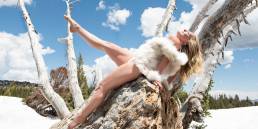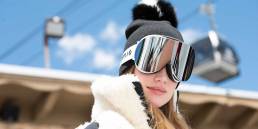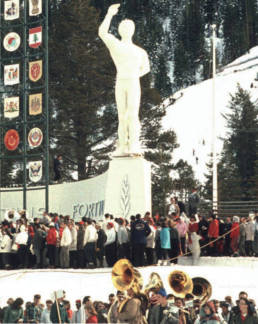
Picture this: Audrey Hepburn on the big screen. Bing Crosby by the bar. Danny Kaye cracking jokes and playing clown. Jayne Mansfield showing everyone around. Walt Disney smiling by a crackling ski lodge fire, a Gitanes cigarette aloft in his hand. Is this Hollywood? No, it’s the 1960 Olympic Winter Games.
Hubris had everything to do with the making of “the greatest show on earth.” Alexander “Pin” Cushing-a tall East Coaster as cocky as the king of spades-was floundering in his efforts to develop Squaw Valley near Tahoe in 1954.
He had one lift, one lodge, and no good highway. Cushing needed: a) capital, b) customers and c) a publicity stunt. Gifted with the kind of confidence that comes with a Newport pedigree and a Harvard law degree, Cushing called the press. He expressed a blithe desire to host the 1960 Olympics. “I had no more interest in getting the games than the man on the moon,” Cushing admitted to Time in 1959, “it was just
a way of getting some newspaper space.” Yet once the first pitch was thrown, Cushing-a former Groton first baseman -refused to be struck out. First, he persuaded his family friend Laurance Rockefeller (son of John D. Rockefeller, Jr.) to
give him funds. Next, California legislators were convinced. Within weeks, Cushing’s podunk Squaw Valley was the USA’s official nominee and it was off to Paris to convince the IOC. Up against Innsbruck, St. Moritz, and Garmisch, the US bid was
a longshot-a nose picker in European minds. “Don’t think you are going to parlay one ski lift into an Olympic Game,” one Euro delegate sniffed at Cushing. His pitch promised a return to simplicity and Olympic ideals. “He played the IOC members like a violinist stroking a Stradivarius,” one journalist wrote. To the astonishment of all, Squaw Valley was named host of the VIII Olympic Winter Games. Enter Walt Disney on stage left. Yes, that Walt Disney. The cartoonist was an avid if novice skier; home movies of Walt on snow inspired Goofy’s antics in How To Ski (1941). Disney was among the first to invest in Sugar Bowl in the 1930s, and his development of California’s Mineral King was a lifelong dream that never got off the ground. In the Sierras, Mount Disney is named after Walt. Disney was hired as chair of the Pageantry Committee a year before the Games’ start. Olympic boss Prentis Hale flew to Burbank to meet Walt and do lunch. It must have been a very good lunch for, by the time coffee arrived, Disney, “Showman of the World”, was the maestro of what Variety ultimately dubbed “the greatest show on Earth.”
Disney recruited within his own organization to stupefy athletes and crowds. As these were the first Winter Games
to be televised, spectacles were a must. Among them, more
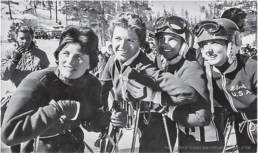
Olympic firsts: l. Dazzling fireworks and choirs singing in lt’sA-Small-World style. 2. Giant snow statues of skiers, skaters, and hockey players reminiscent of ancient Greece, and rows of flags lined the Avenue of Athletes, all paid for by sponsors to offset venue construction costs unheard of at any Olympics to date. 3. A “symphonic carillon”: 116 bells ringing out across the valley three times a day, along with a dole of”doves” released at Opening Ceremonies to signify peace.
Not all went like clockwork. Trucked up from Pasadena, the 16-foot white statues (made of plaster, not snow) arrived covered in soot. The doves of peace were, in truth, homing pigeons as it was feared doves would freeze to death, refuse to fly away, or both. (As it was, a few of the homing pigeons were too fat to take flight.) Scheduled to open the Games, Vice
President Richard Nixon along with legions of Olympic fans was delayed on a snarled highway; no one knew if anyone would make it in time. In fact, it snowed so heavily in the days leading up to the Games, US troops were called to boot-pack the slopes, actress Jayne Mansfield leading the charge.
Walt’s greatest worry should have been the blustery storm that raged on opening day. Miraculously, like the sweep of
a curtain in a Broadway show, the clouds parted just as the ceremonies began. Disney remained unflappable. “If you live right,” he told TV’s Art Linkletter, “things happen the way they’re supposed to.”
“It was a magic, magic Olympics.” This is from Canadian skier Nancy Greene, who was a mere 16 at the time. Her roommate in the Olympic Village-the building of which
set another precedent-was Anne Heggtveit. A fellow Canadian, Heggtveit won 1960 slalom gold with an astonishing 3.3-second lead over silver medalist Betsy Snite (USA) and seven seconds over bronze medalist Barbi Henneberger
(Germany). Heggtveit recalls an Olympics filled with malted milkshakes and Hollywood stars. “There was a hut set up for athletes with a free milk bar-milkshakes any time of the day! And I remember seeing Tony Curtis and Janet Leigh just wandering around.”
Walt Disney called on his Burbank connections to bring out the stars. Nightly entertainment for athletes in the dining hall included Jack Benny, Red Skelton, Esther Williams, and Marlene Dietrich. Roy Rogers and Dale Evans moseyed in, along with cast members from Zorro. Jayne Mansfield was
the “official press hostess”. Screenings for athletes in Hollywood films included Lana Turner in Peyton Place and Audrey Hepburn in Funny Face. Performer Danny Kaye spoofed
an officious Olympic fire marshal who’d insisted the room was over capacity and must be cleared or he’d stop Kaye’s show. Fluent in 12 languages, the actor/comedian repeated the marshal’s orders over and over in German, French, etc … bringing the international house down. Anne Heggtveit
was interviewed by Bing Crosby after her win; “(he kept) interrupting me when I tried to answer!” She adds that in one nightly show, “a guy who did hypnosis” offered to “free athletes from stress” … with disastrous results. Heggtveit says: “All three volunteers, including skier Nancy Holland, crashed in their next events.”



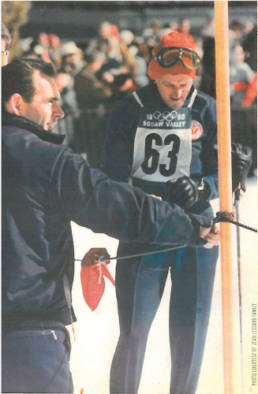
1960 was also the year Jean Vuarnet mastered his site de rouge, a brand new egg-like “tuck” that won him downhill gold. USA’s Penny Pitou was making headlines in Sports Illustrated as “the bouncy blonde from New Hampshire.” As she told the Concord Monitor in 2018: “Just before the downhill, Hollywood called me and wanted me to do a screen test. I said I can’t do that because I’m racing in the downhill tomorrow, and they asked, ‘How about the next day?'”
Penny Pitou did not go on to star in movies, Jean Vuarnet did go on to
style sunglasses, and Anne Heggtveit retired from skiing after receiving a congratulatory telegram from the Queen. In the early ’80s, with its massive
A-frame windows and iconic flags, Squaw’s main Olympic venue, the Blyth Arena, collapsed under the weight of snow and became a parking lot. Still, the VIII Winter Olympic Games gave AlecCushing’s backwater resort an $SO-million boost. And if you Google it, you can learn on YouTube “how Walt Disney changed the Olympics”, the greatest show on Earth.



